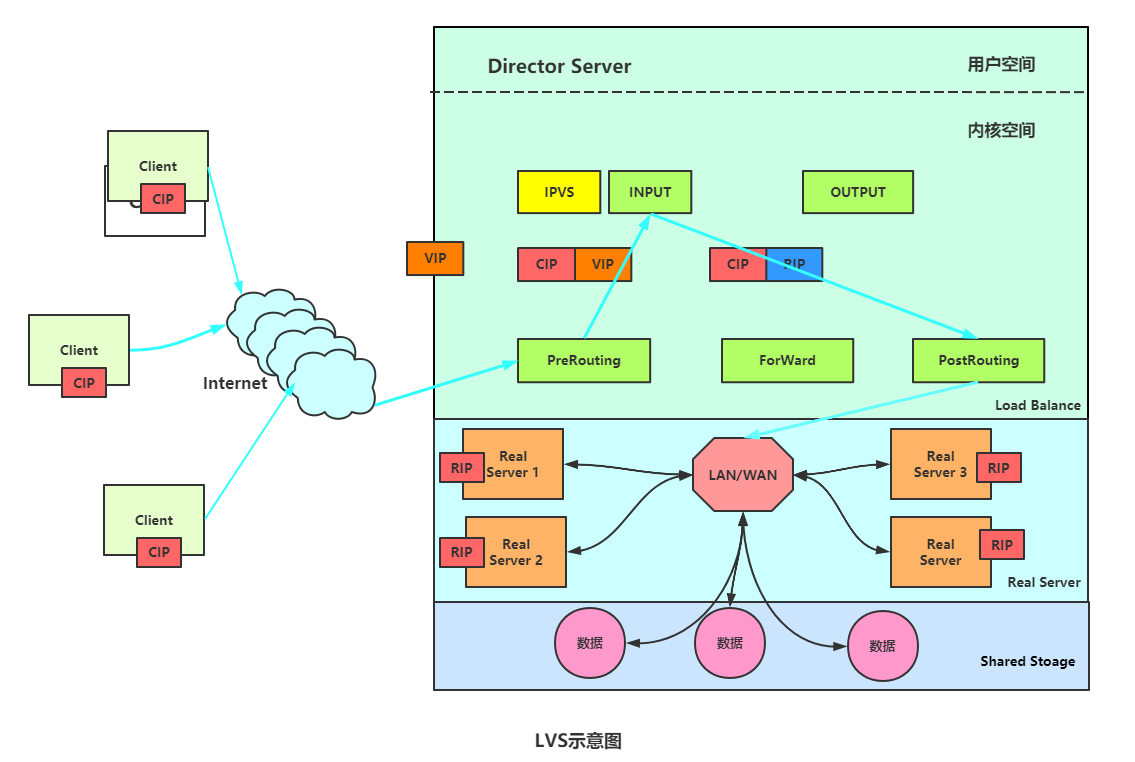LVS负载均衡IP隧道模式原理介绍以及配置实战
LVS 基本工作原理
- 当用户向负载均衡调度器(Director Server)发起请求,调度器将请求发往至内核空间
- PREROUTING 链首先会接收到用户请求,判断目标 IP 确定是本机 IP,将数据包发往 INPUT 链
- IPVS 是工作在 INPUT 链上的,当用户请求到达 INPUT 时,IPVS 会将用户请求和自己已定义好的集群服务进行比对,如果用户请求的就是定义的集群服务,那么此时 IPVS 会强行修改数据包里的目标 IP 地址及端口,并将新的数据包发往 POSTROUTING 链
- POSTROUTING 链接收数据包后发现目标 IP 地址刚好是自己的后端服务器,那么此时通过选路,将数据包最终发送给后端的服务器
对LVS基本概念不太了解的,先维基百科或者参考:LVS负载均衡理论以及算法概要
LVS 的组成
LVS 由 2 部分程序组成,包括 ipvs 和 ipvsadm。
- ipvs(ip virtual server):一段代码工作在内核空间,叫 ipvs,是真正生效实现调度的代码。
- ipvsadm:另外一段是工作在用户空间,叫 ipvsadm,负责为 ipvs 内核框架编写规则,定义谁是集群服务,而谁是后端真实的服务器 (Real Server)
LVS 和 Keepalived
在 lvs+keepalived 环境里面,lvs 主要的工作是提供调度算法,把客户端请求按照需求调度在 real 服务器,keepalived 主要的工作是提供 lvs 控制器的一个冗余,并且对 real 服务器做健康检查,发现不健康的 real 服务器,就把它从 lvs 集群中剔除,real 服务器只负责提供服务。
LVS/TUN
在原有的 IP 报文外再次封装多一层 IP 首部,内部 IP 首部 (源地址为 CIP,目标 IIP 为 VIP),外层 IP 首部 (源地址为 DIP,目标 IP 为 RIP)
(1) 当用户请求到达 Director Server,此时请求的数据报文会先到内核空间的 PREROUTING 链。 此时报文的源 IP 为 CIP,目标 IP 为 VIP 。
(2) PREROUTING 检查发现数据包的目标 IP 是本机,将数据包送至 INPUT 链
(3) IPVS 比对数据包请求的服务是否为集群服务,若是,在请求报文的首部再次封装一层 IP 报文,封装源 IP 为 DIP,目标 IP 为 RIP。然后发至 POSTROUTING 链。 此时源 IP 为 DIP,目标 IP 为 RIP
(4) POSTROUTING 链根据最新封装的 IP 报文,将数据包发至 RS(因为在外层封装多了一层 IP 首部,所以可以理解为此时通过隧道传输)。 此时源 IP 为 DIP,目标 IP 为 RIP
(5) RS 接收到报文后发现是自己的 IP 地址,就将报文接收下来,拆除掉最外层的 IP 后,会发现里面还有一层 IP 首部,而且目标是自己的 lo 接口 VIP,那么此时 RS 开始处理此请求,处理完成之后,通过 lo 接口送给 eth0 网卡,然后向外传递。 此时的源 IP 地址为 VIP,目标 IP 为 CIP
(6) 响应报文最终送达至客户端
LVS/TUN 模型特性
- RIP、VIP、DIP 全是公网地址
- RS 的网关不会也不可能指向 DIP
- 所有的请求报文经由 Director Server,但响应报文必须不能进过 Director Server
- 不支持端口映射
- RS 的系统必须支持隧道
其实企业中最常用的是 DR 实现方式,而 NAT 配置上比较简单和方便,后边实践中会总结 DR 和 NAT 具体使用配置过程。
TUN(virtual server via ip tunneling IP 隧道)调度器把请求的报文通过 IP 隧道转发到真实的服务器。真实的服务器将响应处理后的数据直接返回给客户端。这样调度器就只处理请求入站报文。此转发方式不修改请求报文的 IP 首部(源 IP 为 CIP,目标 IP 为 VIP),而在原 IP 报文之外再封装一个 IP 首部(源 IP 是 DIP,目标 IP 是 RIP),将报文发往挑选出的目标 RS;RS 直接响应给客户端(源 IP 是 VIP,目标 IP 是 CIP),由于一般网络服务应答数据比请求报文大很多,采用 lvs-tun 模式后,集群系统的最大吞吐量可以提高 10 倍
注意事项
(1) DIP, VIP, RIP 都应该是公网地址;
(2) RS 的网关不能,也不可能指向 DIP;
(3) 请求报文要经由 Director,但响应不能经由 Director;
(4) 此模式不支持端口映射;
(5) RS 的操作系统得支持隧道功能
缺点: 由于后端服务器 RS 处理数据后响应发送给用户,此时需要租借大量 IP(特别是后端服务器使用较多的情况下)。
优点: 实现 lvs-tun 模式时,LVS 调度器将 TCP/IP 请求进行重新封装并转发给后端服务器,由目标应用服务器直接回复用户。应用服务器之间是通过 IP 隧道来进行转发,故两者可以存在于不同的网段中。
配置 LVS-TUN
DS端
RS端
这一步的主要目的是让 RS 禁言,在相对较新的版本中新增了两个内核参数 (kernel parameter)
- 第一个是 arp_ignore 定义接受到 ARP 请求时的相应级别
- 第二个是 arp_announce 定义将自己地址向外通告是的通告级别
- 第三个是 rp_filter 定义系统是否开启对数据包源地址的校验
总结: LVS/TUN 是所有模式中最最适用于跨网络跨地域地理位置的一种模式,需要注意的是:
- 若 DIR 和 RIP 在不同 lan 网络中,比如不同的网段,不同的 IDC 机房,就不需要设置 arp 仰制,不同网段中,arp 会被屏蔽掉,所以只需设置 ip tunne 以及报文反向验证即可;
- 若 DIR 和 RIP 在同一广播域中,需要和 LVS/DR 模式一样在所有的 RIP 上仰制 arp,防止 arp 响应导致 arp 表混乱,这样 lvs 就不能正常工作!
配置时除了配置 DIR,还需要需要配置后端 RS server,即在 tunl 上口配置 vip 地址(需要系统支持 tunl 才行),广播为为自己,此模式下无需开启路由转发功能!
配置 LVS/DR 和 LVS/TUN 混合模式
DS端
RS端
DR 和 TUN 的模式基本不用做改动
__EOF__
本文链接:https://www.cnblogs.com/Courage129/p/14334382.html
关于博主:评论和私信会在第一时间回复。或者直接私信我。
版权声明:本博客所有文章除特别声明外,均采用 BY-NC-SA 许可协议。转载请注明出处!
声援博主:如果您觉得文章对您有帮助,可以点击文章右下角【推荐】一下。您的鼓励是博主的最大动力!

 本文主要介绍了LVS基本原理、LVS基本组成、LVS-TUN模式的原理以及模型特性、如何配置LVS-TUN模式以及如何配置DR-TUN混合模式。
本文主要介绍了LVS基本原理、LVS基本组成、LVS-TUN模式的原理以及模型特性、如何配置LVS-TUN模式以及如何配置DR-TUN混合模式。



【推荐】国内首个AI IDE,深度理解中文开发场景,立即下载体验Trae
【推荐】编程新体验,更懂你的AI,立即体验豆包MarsCode编程助手
【推荐】抖音旗下AI助手豆包,你的智能百科全书,全免费不限次数
【推荐】轻量又高性能的 SSH 工具 IShell:AI 加持,快人一步
· go语言实现终端里的倒计时
· 如何编写易于单元测试的代码
· 10年+ .NET Coder 心语,封装的思维:从隐藏、稳定开始理解其本质意义
· .NET Core 中如何实现缓存的预热?
· 从 HTTP 原因短语缺失研究 HTTP/2 和 HTTP/3 的设计差异
· 周边上新:园子的第一款马克杯温暖上架
· 分享 3 个 .NET 开源的文件压缩处理库,助力快速实现文件压缩解压功能!
· Ollama——大语言模型本地部署的极速利器
· DeepSeek如何颠覆传统软件测试?测试工程师会被淘汰吗?
· 使用C#创建一个MCP客户端